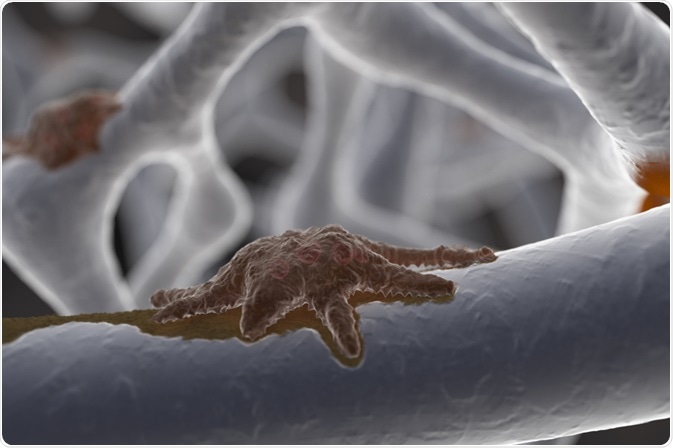What is the normal role of osteoclasts?
Bone regeneration in the human body is a complex process that involves different cell types such as chondrocytes, endothelial cells, mesenchymal stem cells, osteoblasts, and osteoclasts.

Image Credit: SciePro/Shutterstock.com
An osteoclast is a relatively large multinucleate cell formed from macrophages. Osteoclasts are responsible for resorbing bone cells, whereas osteoblasts are responsible for generating bone cells.
These processes of bone formation and bone resorption are closely related and essential to normal bone regeneration processes.
Osteoclasts are found on the bone’s outer layer, just beneath the periosteum. The process of bone resorption is initiated when the osteoclast attaches to the osteon.
Following attachment to the osteon, the osteoclast begins in the folding of its cell membrane and secretes collagenase. As the folded osteoclast tunnels into the mineralized bone, a number of key minerals are released into the extracellular fluid, resulting in a transfer of calcium from bone tissue to the bloodstream.
This process of bone repair is not just something that occurs in bone damage. Continued bone remodeling, which is part of the body’s homeostatic processes, helps us maintain bone strength. Old bone is constantly replaced by newly synthesized bone during a process in which osteoclasts resorb bone then osteoblasts deposit new bone.
Every year, over two million people around the world undergo some kind of bone-grafting procedure. Bone repair processes are essential to the success of procedures such as trauma surgery, joint-like hip and knee revision and reconstruction, spinal fusion and craniomaxillofacial surgery.
Osteoclast action is important in these applications to achieve effective bone regeneration.
Applications of osteoclasts
In bone repair, the main application of osteoclasts is to break down scaffolding. The approach of scaffold-based bone regeneration is used to assist in bone graft procedures in order to regenerate lost bone and treat fractures.
Achieving success in bone regeneration procedures can be difficult because it involves a number of biochemical and mechanical processes. Success often hinges on the type of biomaterial used in the scaffolding.
However, there is currently a major barrier to success, as there is a limited understanding of how biomaterials interact with osteoclasts. Expanding scientific understanding of these interactions is essential to improving the effectiveness of bone regeneration procedures.
It is commonly accepted that to achieve the complete reconstruction of diseased/damaged bone tissue, the scaffolds used to facilitate this repair should be completely broken down over time.
The degradation of synthetic bone substitute materials includes both chemical dissolution (physicochemical degradation) and resorption (cellular degradation by osteoclasts).
While osteoclasts are known to play a vital role in bone resorption in natural bone remodeling, little is known about how they function in regard to breaking down the biomaterials used in scaffolding.
Surgeons place the scaffolds in a place within the bone tissue, ensuring that it is at least partially covered with this tissue. Bone remodeling processes begin with osteoclasts which attached themselves to the surface of the bone, initiating an acidic environment, which leads to breakdown of the bone matrix and resorption cavity. Then, osteoblasts move in to complete their part of the process by filling the cavity with new bone tissue. In addition, another type of cells, known as osteocytes, can behave as conductors that oversee this process.
What is the next step?
More research is needed to investigate exactly how osteoclasts act on biomaterials in order to repair damaged bone with higher success rates. While we currently know how they act in natural bone repair process, there is a gap in our knowledge of their behavior in clinical procedures of bone repair.
Gaining this understanding will allow scientists to develop more compatible biomaterials and more effective methods of bone repair.
Sources:
- Schneider, S. (2017). Patient-specific design of tissue engineering scaffolds, based on mathematical modeling. Advances in Ceramic Biomaterials, pp.391–406.
- Bahney CS, Zondervan RL, Allison P, et al. Cellular biology of fracture healing. J Orthop Res. 2019;37(1):35–50. doi:10.1002/jor.24170
- Arvidson K, Abdallah BM, Applegate LA, et al. Bone regeneration and stem cells. J Cell Mol Med. 2011;15(4):718–746. doi:10.1111/j.1582-4934.2010.01224.x
- Detsch, R., and Boccaccini, A. R. ( 2015) The role of osteoclasts in bone tissue engineering. J Tissue Eng Regen Med, 9: 1133– 1149. doi: 10.1002/term.1851.
Further Reading
Last Updated: Feb 24, 2020